Yufei Zhang
Chair of Architecture and Building Systems
OneRec-V2 Technical Report
Aug 28, 2025Abstract:Recent breakthroughs in generative AI have transformed recommender systems through end-to-end generation. OneRec reformulates recommendation as an autoregressive generation task, achieving high Model FLOPs Utilization. While OneRec-V1 has shown significant empirical success in real-world deployment, two critical challenges hinder its scalability and performance: (1) inefficient computational allocation where 97.66% of resources are consumed by sequence encoding rather than generation, and (2) limitations in reinforcement learning relying solely on reward models. To address these challenges, we propose OneRec-V2, featuring: (1) Lazy Decoder-Only Architecture: Eliminates encoder bottlenecks, reducing total computation by 94% and training resources by 90%, enabling successful scaling to 8B parameters. (2) Preference Alignment with Real-World User Interactions: Incorporates Duration-Aware Reward Shaping and Adaptive Ratio Clipping to better align with user preferences using real-world feedback. Extensive A/B tests on Kuaishou demonstrate OneRec-V2's effectiveness, improving App Stay Time by 0.467%/0.741% while balancing multi-objective recommendations. This work advances generative recommendation scalability and alignment with real-world feedback, representing a step forward in the development of end-to-end recommender systems.
OneRec Technical Report
Jun 16, 2025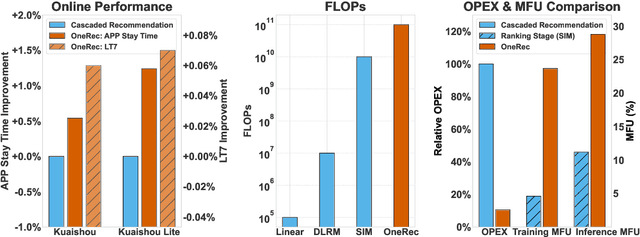

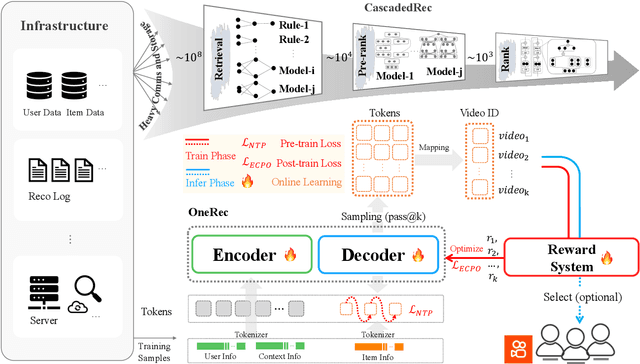

Abstract:Recommender systems have been widely used in various large-scale user-oriented platforms for many years. However, compared to the rapid developments in the AI community, recommendation systems have not achieved a breakthrough in recent years. For instance, they still rely on a multi-stage cascaded architecture rather than an end-to-end approach, leading to computational fragmentation and optimization inconsistencies, and hindering the effective application of key breakthrough technologies from the AI community in recommendation scenarios. To address these issues, we propose OneRec, which reshapes the recommendation system through an end-to-end generative approach and achieves promising results. Firstly, we have enhanced the computational FLOPs of the current recommendation model by 10 $\times$ and have identified the scaling laws for recommendations within certain boundaries. Secondly, reinforcement learning techniques, previously difficult to apply for optimizing recommendations, show significant potential in this framework. Lastly, through infrastructure optimizations, we have achieved 23.7% and 28.8% Model FLOPs Utilization (MFU) on flagship GPUs during training and inference, respectively, aligning closely with the LLM community. This architecture significantly reduces communication and storage overhead, resulting in operating expense that is only 10.6% of traditional recommendation pipelines. Deployed in Kuaishou/Kuaishou Lite APP, it handles 25% of total queries per second, enhancing overall App Stay Time by 0.54% and 1.24%, respectively. Additionally, we have observed significant increases in metrics such as 7-day Lifetime, which is a crucial indicator of recommendation experience. We also provide practical lessons and insights derived from developing, optimizing, and maintaining a production-scale recommendation system with significant real-world impact.
Com$^2$: A Causal-Guided Benchmark for Exploring Complex Commonsense Reasoning in Large Language Models
Jun 08, 2025Abstract:Large language models (LLMs) have mastered abundant simple and explicit commonsense knowledge through pre-training, enabling them to achieve human-like performance in simple commonsense reasoning. Nevertheless, LLMs struggle to reason with complex and implicit commonsense knowledge that is derived from simple ones (such as understanding the long-term effects of certain events), an aspect humans tend to focus on more. Existing works focus on complex tasks like math and code, while complex commonsense reasoning remains underexplored due to its uncertainty and lack of structure. To fill this gap and align with real-world concerns, we propose a benchmark Com$^2$ focusing on complex commonsense reasoning. We first incorporate causal event graphs to serve as structured complex commonsense. Then we adopt causal theory~(e.g., intervention) to modify the causal event graphs and obtain different scenarios that meet human concerns. Finally, an LLM is employed to synthesize examples with slow thinking, which is guided by the logical relationships in the modified causal graphs. Furthermore, we use detective stories to construct a more challenging subset. Experiments show that LLMs struggle in reasoning depth and breadth, while post-training and slow thinking can alleviate this. The code and data are available at https://github.com/Waste-Wood/Com2.
Hi-LSplat: Hierarchical 3D Language Gaussian Splatting
Jun 07, 2025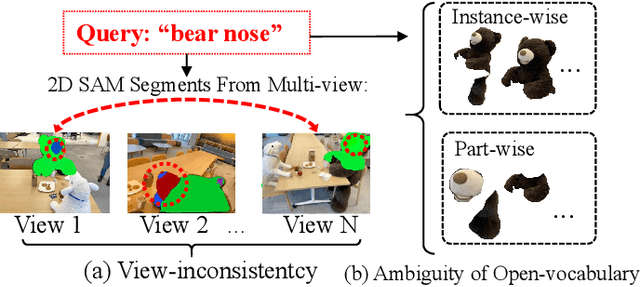
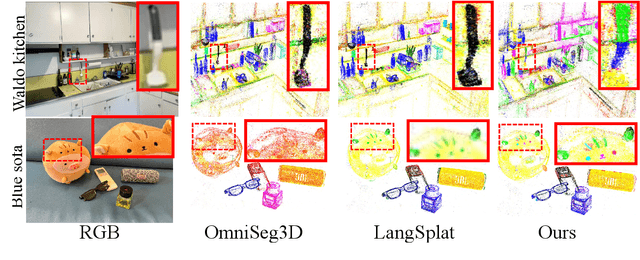
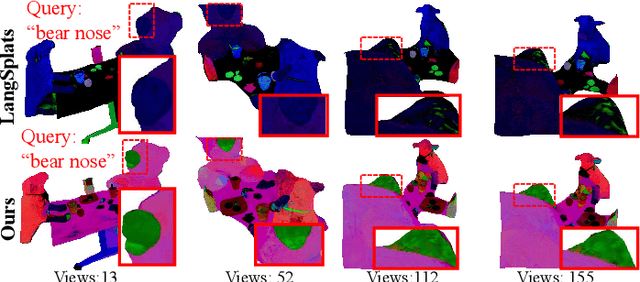

Abstract:Modeling 3D language fields with Gaussian Splatting for open-ended language queries has recently garnered increasing attention. However, recent 3DGS-based models leverage view-dependent 2D foundation models to refine 3D semantics but lack a unified 3D representation, leading to view inconsistencies. Additionally, inherent open-vocabulary challenges cause inconsistencies in object and relational descriptions, impeding hierarchical semantic understanding. In this paper, we propose Hi-LSplat, a view-consistent Hierarchical Language Gaussian Splatting work for 3D open-vocabulary querying. To achieve view-consistent 3D hierarchical semantics, we first lift 2D features to 3D features by constructing a 3D hierarchical semantic tree with layered instance clustering, which addresses the view inconsistency issue caused by 2D semantic features. Besides, we introduce instance-wise and part-wise contrastive losses to capture all-sided hierarchical semantic representations. Notably, we construct two hierarchical semantic datasets to better assess the model's ability to distinguish different semantic levels. Extensive experiments highlight our method's superiority in 3D open-vocabulary segmentation and localization. Its strong performance on hierarchical semantic datasets underscores its ability to capture complex hierarchical semantics within 3D scenes.
Policy Optimization for Continuous-time Linear-Quadratic Graphon Mean Field Games
Jun 06, 2025Abstract:Multi-agent reinforcement learning, despite its popularity and empirical success, faces significant scalability challenges in large-population dynamic games. Graphon mean field games (GMFGs) offer a principled framework for approximating such games while capturing heterogeneity among players. In this paper, we propose and analyze a policy optimization framework for continuous-time, finite-horizon linear-quadratic GMFGs. Exploiting the structural properties of GMFGs, we design an efficient policy parameterization in which each player's policy is represented as an affine function of their private state, with a shared slope function and player-specific intercepts. We develop a bilevel optimization algorithm that alternates between policy gradient updates for best-response computation under a fixed population distribution, and distribution updates using the resulting policies. We prove linear convergence of the policy gradient steps to best-response policies and establish global convergence of the overall algorithm to the Nash equilibrium. The analysis relies on novel landscape characterizations over infinite-dimensional policy spaces. Numerical experiments demonstrate the convergence and robustness of the proposed algorithm under varying graphon structures, noise levels, and action frequencies.
Self-Route: Automatic Mode Switching via Capability Estimation for Efficient Reasoning
May 27, 2025Abstract:While reasoning-augmented large language models (RLLMs) significantly enhance complex task performance through extended reasoning chains, they inevitably introduce substantial unnecessary token consumption, particularly for simpler problems where Short Chain-of-Thought (Short CoT) suffices. This overthinking phenomenon leads to inefficient resource usage without proportional accuracy gains. To address this issue, we propose Self-Route, a dynamic reasoning framework that automatically selects between general and reasoning modes based on model capability estimation. Our approach introduces a lightweight pre-inference stage to extract capability-aware embeddings from hidden layer representations, enabling real-time evaluation of the model's ability to solve problems. We further construct Gradient-10K, a model difficulty estimation-based dataset with dense complexity sampling, to train the router for precise capability boundary detection. Extensive experiments demonstrate that Self-Route achieves comparable accuracy to reasoning models while reducing token consumption by 30-55\% across diverse benchmarks. The proposed framework demonstrates consistent effectiveness across models with different parameter scales and reasoning paradigms, highlighting its general applicability and practical value.
Beyond Static Testbeds: An Interaction-Centric Agent Simulation Platform for Dynamic Recommender Systems
May 22, 2025Abstract:Evaluating and iterating upon recommender systems is crucial, yet traditional A/B testing is resource-intensive, and offline methods struggle with dynamic user-platform interactions. While agent-based simulation is promising, existing platforms often lack a mechanism for user actions to dynamically reshape the environment. To bridge this gap, we introduce RecInter, a novel agent-based simulation platform for recommender systems featuring a robust interaction mechanism. In RecInter platform, simulated user actions (e.g., likes, reviews, purchases) dynamically update item attributes in real-time, and introduced Merchant Agents can reply, fostering a more realistic and evolving ecosystem. High-fidelity simulation is ensured through Multidimensional User Profiling module, Advanced Agent Architecture, and LLM fine-tuned on Chain-of-Thought (CoT) enriched interaction data. Our platform achieves significantly improved simulation credibility and successfully replicates emergent phenomena like Brand Loyalty and the Matthew Effect. Experiments demonstrate that this interaction mechanism is pivotal for simulating realistic system evolution, establishing our platform as a credible testbed for recommender systems research.
From Structural Design to Dynamics Modeling: Control-Oriented Development of a 3-RRR Parallel Ankle Rehabilitation Robot
May 19, 2025Abstract:This paper presents the development of a wearable ankle rehabilitation robot based on a 3-RRR spherical parallel mechanism (SPM) to support multi-DOF recovery through pitch, roll, and yaw motions. The system features a compact, ergonomic structure designed for comfort, safety, and compatibility with ankle biomechanics. A complete design-to-dynamics pipeline has been implemented, including structural design, kinematic modeling for motion planning, and Lagrangian-based dynamic modeling for torque estimation and simulation analysis. Preliminary simulations verify stable joint coordination and smooth motion tracking under representative rehabilitation trajectories. The control framework is currently being developed to enhance responsiveness across the workspace. Future work will focus on integrating personalized modeling and adaptive strategies to address kinematic singularities through model based control. This work establishes a foundational platform for intelligent, personalized ankle rehabilitation, enabling both static training and potential extension to gait-phase-timed assistance.
Efficient Learning for Entropy-regularized Markov Decision Processes via Multilevel Monte Carlo
Mar 27, 2025
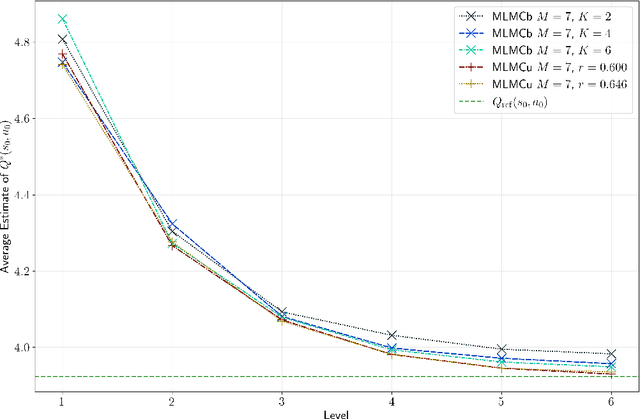
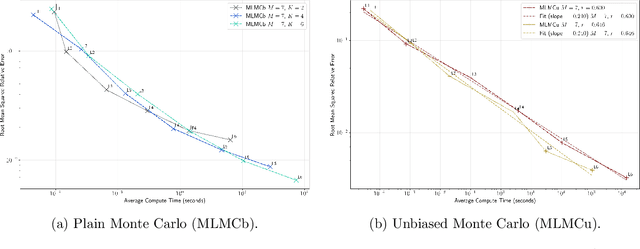

Abstract:Designing efficient learning algorithms with complexity guarantees for Markov decision processes (MDPs) with large or continuous state and action spaces remains a fundamental challenge. We address this challenge for entropy-regularized MDPs with Polish state and action spaces, assuming access to a generative model of the environment. We propose a novel family of multilevel Monte Carlo (MLMC) algorithms that integrate fixed-point iteration with MLMC techniques and a generic stochastic approximation of the Bellman operator. We quantify the precise impact of the chosen approximate Bellman operator on the accuracy of the resulting MLMC estimator. Leveraging this error analysis, we show that using a biased plain MC estimate for the Bellman operator results in quasi-polynomial sample complexity, whereas an unbiased randomized multilevel approximation of the Bellman operator achieves polynomial sample complexity in expectation. Notably, these complexity bounds are independent of the dimensions or cardinalities of the state and action spaces, distinguishing our approach from existing algorithms whose complexities scale with the sizes of these spaces. We validate these theoretical performance guarantees through numerical experiments.
Accuracy of Discretely Sampled Stochastic Policies in Continuous-time Reinforcement Learning
Mar 13, 2025Abstract:Stochastic policies are widely used in continuous-time reinforcement learning algorithms. However, executing a stochastic policy and evaluating its performance in a continuous-time environment remain open challenges. This work introduces and rigorously analyzes a policy execution framework that samples actions from a stochastic policy at discrete time points and implements them as piecewise constant controls. We prove that as the sampling mesh size tends to zero, the controlled state process converges weakly to the dynamics with coefficients aggregated according to the stochastic policy. We explicitly quantify the convergence rate based on the regularity of the coefficients and establish an optimal first-order convergence rate for sufficiently regular coefficients. Additionally, we show that the same convergence rates hold with high probability concerning the sampling noise, and further establish a $1/2$-order almost sure convergence when the volatility is not controlled. Building on these results, we analyze the bias and variance of various policy evaluation and policy gradient estimators based on discrete-time observations. Our results provide theoretical justification for the exploratory stochastic control framework in [H. Wang, T. Zariphopoulou, and X.Y. Zhou, J. Mach. Learn. Res., 21 (2020), pp. 1-34].
 Add to Chrome
Add to Chrome Add to Firefox
Add to Firefox Add to Edge
Add to Edge